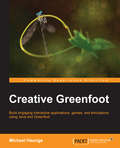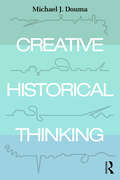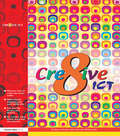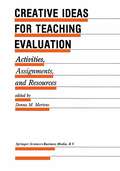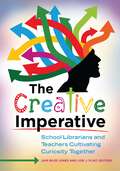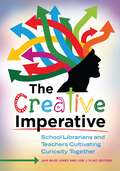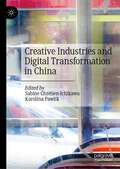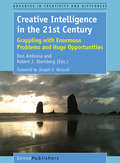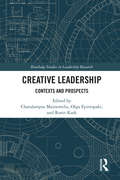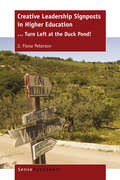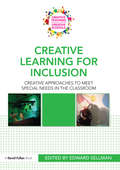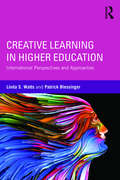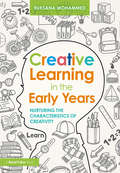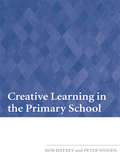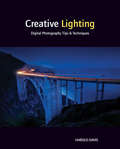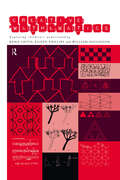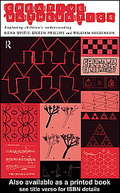- Table View
- List View
Creative Greenfoot
by Michael HaungsThis book is for coding students and Java programmers of all levels interested in building engaging, interactive applications with Greenfoot. Familiarity with the very basics of Greenfoot is assumed.
Creative Historical Thinking
by Michael DoumaCreative Historical Thinking offers innovative approaches to thinking and writing about history. Author Michael J. Douma makes the case that history should be recognized as a subject intimately related to individual experience and positions its practice as an inherently creative endeavor. Douma describes the nature of creativity in historical thought, illustrates his points with case studies and examples. He asserts history’s position as a collective and community-building exercise and argues for the importance of metaphor and other creative tools in communicating about history with people who may view the past in fundamentally different ways. A practical guide and an inspiring affirmation of the personal and communal value of history, Creative Historical Thinking has much to offer to both current and aspiring historians.
Creative Historical Thinking
by Michael DoumaCreative Historical Thinking offers innovative approaches to thinking and writing about history. Author Michael J. Douma makes the case that history should be recognized as a subject intimately related to individual experience and positions its practice as an inherently creative endeavor. Douma describes the nature of creativity in historical thought, illustrates his points with case studies and examples. He asserts history’s position as a collective and community-building exercise and argues for the importance of metaphor and other creative tools in communicating about history with people who may view the past in fundamentally different ways. A practical guide and an inspiring affirmation of the personal and communal value of history, Creative Historical Thinking has much to offer to both current and aspiring historians.
Creative ICT
by Antony Smith Simon WillcocksFirst Published in 2005. Routledge is an imprint of Taylor & Francis, an informa company.
Creative ICT
by Antony Smith Simon WillcocksFirst Published in 2005. Routledge is an imprint of Taylor & Francis, an informa company.
Creative Ideas For Teaching Evaluation: Activities, Assignments and Resources (Evaluation in Education and Human Services #24)
by Donna M. MertensIn 1976, the first session on the teaching of evaluation was held at an annual meeting of evaluators. A few hardy souls gathered to exchange ideas on improving the teaching of evaluation. At subsequent annual meetings, these informal sessions attracted more and more participants, eager to talk about common teaching interests and to exchange reading lists, syllabuses, assignments, and paper topics. The ses sions were irreverent, innovative, lively, and unpredictable. Eventually the group for malized itself with the American Evaluation Association as the Topical Interest Group in the Teaching of Evaluation (TIG: TOE). As word of TIG: TOE's activities spread, instructors from all over the country clamored for assistance and advice. It became apparent that a handbook was need ed, a practical interdisciplinary guide to the teaching of evaluation. Donna M. Mertens, a long-standing member of TIG: TOE and an accomplished teacher of evaluation, volunteered to edit the book, and her skills, sensitivity, and experience in the craft of teaching are apparent throughout.
The Creative Imperative: School Librarians and Teachers Cultivating Curiosity Together
by Jami Biles Jones and Lori J. FlintProvides a solid, foundational understanding of creativity that enables readers to elicit creative performance from their students.The first book of its kind in the school library field, The Creative Imperative: School Librarians and Teachers Cultivating Curiosity Together assists educators, school librarians, school counselors, and parents in learning about creativity and inquiry as well as how to foster these desired processes in school settings and beyond. The work begins by addressing the foundational aspects of creativity, and then discusses creativity within the educational setting, exploring how educators can be more creative themselves and coax creative performance from their students. The final part of the text focuses specifically on school libraries and the role of librarians in developing environments and opportunities for inquiry that nurture creativity.
The Creative Imperative: School Librarians and Teachers Cultivating Curiosity Together
by Jami Biles Jones Lori J. FlintProvides a solid, foundational understanding of creativity that enables readers to elicit creative performance from their students.The first book of its kind in the school library field, The Creative Imperative: School Librarians and Teachers Cultivating Curiosity Together assists educators, school librarians, school counselors, and parents in learning about creativity and inquiry as well as how to foster these desired processes in school settings and beyond. The work begins by addressing the foundational aspects of creativity, and then discusses creativity within the educational setting, exploring how educators can be more creative themselves and coax creative performance from their students. The final part of the text focuses specifically on school libraries and the role of librarians in developing environments and opportunities for inquiry that nurture creativity.
Creative Industries and Digital Transformation in China
by Sabine Chrétien-Ichikawa Karolina PawlikAs China gains momentum in economic terms, its technological transformation, cultural confidence, and creative influence also grow steadily. This book explores socio-cultural context, in which new trends, enabled by the power of digital technology, emerge. Focused on the urban context, in China's large cities like Shanghai, and through the lens of art, design, fashion, gaming, and media industries, this book highlights innovation processes in the making, as well as ongoing shifts in Chinese identities and narratives. This collaborative work written by European authors based in China offer new insights from within. Their shared, yet multi-faceted, engagement with China and its creative industries culminates in this book written for international scholars, students, and industry players.
Creative Intelligence in the 21st Century: Grappling with Enormous Problems and Huge Opportunities (Advances in Creativity and Giftedness #11)
by Don Ambrose Robert J. SternbergHow can creative individuals and societies adapt to complex 21st-century conditions? Will civilizations thrive or collapse in the decades to come if they are not creative enough, or if they are too creative? Interest in these questions is growing; however, until now there has been inadequate understanding of the socioeconomic and cultural trends and issues that influence creativity. This book provides that understanding while yielding insights from many of the world’s leading creativity researchers and educational experts. The book begins with a big-picture, interdisciplinary overview of the socioeconomic, cultural, and technological pressures emerging from 21st-century globalization and describes some ways in which those pressures simultaneously suppress, distort, and invigorate creativity in general, and creative education in particular. After that, prominent scholars of creativity and education use their impressive knowledge bases to clarify how we can adjust our thoughts and actions in order to give ourselves the best possible chances for success in this complex world. “The world’s problems are complex, messy, and seemingly intractable, but history tells us that human creativity finds solutions to even the most daunting problems. This book collects perspectives on creative development from many of the most respected scholars and educators working in creativity and innovation today, helping chart a path forward for creativity in the 21st century.” – Jonathan Plucker, Julian C. Stanley Endowed Professor of Talent Development, Johns Hopkins University “A volume taking on macro-opportunities and macroproblems by editors Ambrose and Sternberg is a treat for readers who want to think ‘big’ and think ‘forward.’ Kick back for an imaginative journey that reaches back to early global insights but propels us solidly into the 21st century and beyond.” – Ann Robinson, Past President, National Association for Gifted Children
Creative Leadership: Contexts and Prospects (Routledge Studies in Leadership Research)
by Charalampos Mainemelis Olga Epitropaki Ronit KarkThere has never been a better time to study, practice, and experience creative leadership. In the fluid and turbulent economic and social environments of the 21st century, creative leadership has become a cardinal force in the creation and evolution of adaptive organizations. In the last two decades, organizational science has witnessed a rapid increase in the number of studies on the nature, skills, and processes of creative leadership. The resulting accumulated body of knowledge has remained for many years dispersed and fragmented across multiple strands of organizational research. This volume seeks to foster the cross-fertilization of scientific knowledge and insight by bringing together authoritative contributions from leading scholars whose work is located in different strands of creative leadership research. Creative Leadership: Contexts and Prospects builds upon a recently introduced multi-context framework that integrates metatheoretically three conceptualizations of creative leadership found in the extant literature: Facilitating employee creativity; Directing the materialization of a leader’s creative vision; and Integrating heterogeneous creative contributions. These three conceptualizations reflect essential differences in the enactment of creative leadership across various collaborative contexts of creative work, and they underlie the intellectual efforts of different research strands. The collection of chapters in Creative Leadership: Contexts and Prospects offers the latest thinking on creative leadership in facilitative, directive, and integrative contexts, and a stimulating set of ideas for crafting the next generation of nuanced theories and empirical studies in the field.
Creative Leadership: Contexts and Prospects (Routledge Studies in Leadership Research)
by Charalampos Mainemelis Olga Epitropaki Ronit KarkThere has never been a better time to study, practice, and experience creative leadership. In the fluid and turbulent economic and social environments of the 21st century, creative leadership has become a cardinal force in the creation and evolution of adaptive organizations. In the last two decades, organizational science has witnessed a rapid increase in the number of studies on the nature, skills, and processes of creative leadership. The resulting accumulated body of knowledge has remained for many years dispersed and fragmented across multiple strands of organizational research. This volume seeks to foster the cross-fertilization of scientific knowledge and insight by bringing together authoritative contributions from leading scholars whose work is located in different strands of creative leadership research. Creative Leadership: Contexts and Prospects builds upon a recently introduced multi-context framework that integrates metatheoretically three conceptualizations of creative leadership found in the extant literature: Facilitating employee creativity; Directing the materialization of a leader’s creative vision; and Integrating heterogeneous creative contributions. These three conceptualizations reflect essential differences in the enactment of creative leadership across various collaborative contexts of creative work, and they underlie the intellectual efforts of different research strands. The collection of chapters in Creative Leadership: Contexts and Prospects offers the latest thinking on creative leadership in facilitative, directive, and integrative contexts, and a stimulating set of ideas for crafting the next generation of nuanced theories and empirical studies in the field.
Creative Leadership Signposts in Higher Education: . . . Turn Left at the Duck Pond!
by Fiona J. Peterson"Creative ways of thinking about leadership are helpful to guide practice and personal growth. This book builds a strategic roadmap for creative leadership practice, putting the spotlight on a leader’s professional development journey in the process. The book is about leadership on the ground in higher education, where the ‘rubber hits the road’. It can also be useful in business, or for anyone wanting to think outside the square. Through a creative storytelling approach, the author takes the reader through Tuscany and her on-the-job experience as a leader of learning and teaching. Along the way, she explains some of the theoretical influences on her thinking and practice – in ways and combinations she hadn’t read about in other leadership books, or experienced in professional development programmes. Through real stories, the author shows how she made creative connections in building her own knowledge on present and past experience, with reflection on how practice can be improved with a clear focus on collegiality and strategic outcomes. This approach reflects the five creative leadership signposts that she explains and illustrates throughout the book. "
Creative Learning for Inclusion: Creative approaches to meet special needs in the classroom (Creative Teaching/Creative Schools)
by Edward SellmanIntroducing creativity to the classroom is a concern for teachers, governments and future employers around the world, and there has been a drive to make experiences at school more exciting, relevant, challenging and dynamic for all young people, ensuring they leave education able to contribute to the global creative economy. Creative Learning to Meet Special Needs shows teachers how to use creativity in the curriculum for key stages 2 and 3 to support the learning of pupils with special educational needs in a way which effectively engages them and leaves a lasting impact on their school experiences and later lives. Describing the different ways in which a creative approach can help pupils with SEN access the curriculum, with activities and practical materials for teachers, this book will explain: why creativity is central to making the curriculum accessible how to use personalised learning with pupils with SEN how to promote achievements and motivation through creative experiences how the curriculum can be extended and represented in innovative ways for pupils with SEN how to use interactive methods of teaching and alternative methods of communication. Providing case studies and examples of the ways in which teachers have delivered the curriculum creatively to pupils with special educational needs, this book is an invaluable guide for all those involved in teaching and engaging young people with special needs.
Creative Learning for Inclusion: Creative approaches to meet special needs in the classroom (Creative Teaching/Creative Schools)
by Edward SellmanIntroducing creativity to the classroom is a concern for teachers, governments and future employers around the world, and there has been a drive to make experiences at school more exciting, relevant, challenging and dynamic for all young people, ensuring they leave education able to contribute to the global creative economy. Creative Learning to Meet Special Needs shows teachers how to use creativity in the curriculum for key stages 2 and 3 to support the learning of pupils with special educational needs in a way which effectively engages them and leaves a lasting impact on their school experiences and later lives. Describing the different ways in which a creative approach can help pupils with SEN access the curriculum, with activities and practical materials for teachers, this book will explain: why creativity is central to making the curriculum accessible how to use personalised learning with pupils with SEN how to promote achievements and motivation through creative experiences how the curriculum can be extended and represented in innovative ways for pupils with SEN how to use interactive methods of teaching and alternative methods of communication. Providing case studies and examples of the ways in which teachers have delivered the curriculum creatively to pupils with special educational needs, this book is an invaluable guide for all those involved in teaching and engaging young people with special needs.
Creative Learning in Higher Education: International Perspectives and Approaches
by Patrick Blessinger Linda S. WattsThis book provides higher education faculty and administrators a scholarly resource on the most salient aspects and emerging trends in creative learning in higher education today. International contributors explore ways to foster creativity in any student, regardless of academic discipline or demographic characteristics and demonstrate that creativity is a skill all students can and should learn. Chapters analyzes how different countries and cultures implement creative learning, exploring issues of instruction, assessment, and ultimately how these practices are transforming learning. This important book helps higher education professionals understand and cultivate creative learning across disciplines in any college and university setting.
Creative Learning in Higher Education: International Perspectives and Approaches
by Patrick Blessinger Linda S. WattsThis book provides higher education faculty and administrators a scholarly resource on the most salient aspects and emerging trends in creative learning in higher education today. International contributors explore ways to foster creativity in any student, regardless of academic discipline or demographic characteristics and demonstrate that creativity is a skill all students can and should learn. Chapters analyzes how different countries and cultures implement creative learning, exploring issues of instruction, assessment, and ultimately how these practices are transforming learning. This important book helps higher education professionals understand and cultivate creative learning across disciplines in any college and university setting.
Creative Learning in the Early Years: Nurturing the Characteristics of Creativity
by Ruksana MohammedTaking a fresh look at the role of creativity within the early years, this accessible guide explores what is meant by creativity and considers how creative skills, behaviours, and thinking can be identified and fostered in the individual child. Underpinned by the latest research and policy, chapters illustrate how creative attitudes can be adopted in all subject areas, and opportunities for creativity maximised. Creative Learning in the Early Years acknowledges the power of creative processes in helping children reach their full potential in the early years and beyond. Photocopiable work tools enable the reader to plan, observe, assess, and record progress as they develop playful and creative approaches, whilst practical advice and demonstrable examples are easily integrated into existing practice. Topics addressed include: recognising and encouraging creative tendencies stimulating the child’s imagination developing adult creativity and self-awareness creating enabling environments and creative spaces using documentation and planning to inspire creativity. An exciting and accessible guide which encourages exploration, experimentation, reflection, and development, Creative Learning in the Early Years will support current and future early years practitioners as they discover the rich opportunities opened by creative practice.
Creative Learning in the Early Years: Nurturing the Characteristics of Creativity
by Ruksana MohammedTaking a fresh look at the role of creativity within the early years, this accessible guide explores what is meant by creativity and considers how creative skills, behaviours, and thinking can be identified and fostered in the individual child. Underpinned by the latest research and policy, chapters illustrate how creative attitudes can be adopted in all subject areas, and opportunities for creativity maximised. Creative Learning in the Early Years acknowledges the power of creative processes in helping children reach their full potential in the early years and beyond. Photocopiable work tools enable the reader to plan, observe, assess, and record progress as they develop playful and creative approaches, whilst practical advice and demonstrable examples are easily integrated into existing practice. Topics addressed include: recognising and encouraging creative tendencies stimulating the child’s imagination developing adult creativity and self-awareness creating enabling environments and creative spaces using documentation and planning to inspire creativity. An exciting and accessible guide which encourages exploration, experimentation, reflection, and development, Creative Learning in the Early Years will support current and future early years practitioners as they discover the rich opportunities opened by creative practice.
Creative Learning in the Primary School
by Bob Jeffrey Peter WoodsCreative Learning in the Primary School uses ethnographic research to consider the main features of creative teaching and learning within the context of contemporary policy reforms. In particular, the authors are interested in the clash between two oppositional discourses - creativity and performativity - and how they are resolved in creative teacher practice. The book complements previous work by these authors on creative teaching by giving more consideration to creative learning. The first section of the book explores the nature of creative teaching and learning by examining four key features: relevance, control, ownership and innovation. The authors devote a chapter to each of these aspects, outlining their properties and illustrating them with a wide range of examples, mainly from recent practice in primary schools. The second section presents some instructive examples of schools promoting creative learning, and how creative primary schools have responded to the policy reforms of recent years. The chapters focus specifically on: how pupils act as a powerful resource for creative learning for each other and for their teachers; how teachers have appropriated the reforms to enhance their creativity; and how one school has moved over a period of ten years from heavy constraint to high creativity. The blend of analysis, case-study material and implications for practice will make this book attractive to primary teachers, school managers, policy makers, teacher educators and researchers.
Creative Learning in the Primary School
by Bob Jeffrey Peter WoodsCreative Learning in the Primary School uses ethnographic research to consider the main features of creative teaching and learning within the context of contemporary policy reforms. In particular, the authors are interested in the clash between two oppositional discourses - creativity and performativity - and how they are resolved in creative teacher practice. The book complements previous work by these authors on creative teaching by giving more consideration to creative learning. The first section of the book explores the nature of creative teaching and learning by examining four key features: relevance, control, ownership and innovation. The authors devote a chapter to each of these aspects, outlining their properties and illustrating them with a wide range of examples, mainly from recent practice in primary schools. The second section presents some instructive examples of schools promoting creative learning, and how creative primary schools have responded to the policy reforms of recent years. The chapters focus specifically on: how pupils act as a powerful resource for creative learning for each other and for their teachers; how teachers have appropriated the reforms to enhance their creativity; and how one school has moved over a period of ten years from heavy constraint to high creativity. The blend of analysis, case-study material and implications for practice will make this book attractive to primary teachers, school managers, policy makers, teacher educators and researchers.
Creative Lighting: Digital Photography Tips and Techniques
by Harold DavisHow to make digital photography lighting more creative—and less challenging! How do you master the art of lighting your photographs? Go beyond the basics, go beyond the "rules," and get creative with the help of renowned photographer Harold Davis. In this book, Harold shows you how to break the boundaries of conventional wisdom and create unique, lively, and beautifully lit photographs. Packed with tips and tricks as well as stunning examples of the author’s creativity, this book will both inform and inspire you to create your own lighting style. Teaches you when and how to control the light in your photographs Reviews the basic “rules” of digital photography lighting and shows you how to break the rules to create your own uniquely lit images Helps you start building a lighting style of your own Includes stunning examples of the author’s photography and lighting techniques Whether you're a beginner or a seasoned digital photographer, you'll find ideas and techniques to spark your creativity.
Creative Lighting: Digital Photography Tips and Techniques
by Harold DavisHow to make digital photography lighting more creative—and less challenging! How do you master the art of lighting your photographs? Go beyond the basics, go beyond the "rules," and get creative with the help of renowned photographer Harold Davis. In this book, Harold shows you how to break the boundaries of conventional wisdom and create unique, lively, and beautifully lit photographs. Packed with tips and tricks as well as stunning examples of the author’s creativity, this book will both inform and inspire you to create your own lighting style. Teaches you when and how to control the light in your photographs Reviews the basic “rules” of digital photography lighting and shows you how to break the rules to create your own uniquely lit images Helps you start building a lighting style of your own Includes stunning examples of the author’s photography and lighting techniques Whether you're a beginner or a seasoned digital photographer, you'll find ideas and techniques to spark your creativity.
Creative Mathematics
by William Higginson Eileen Phillips Rena UpitisThis book shows how creative maths can really work. Exploring the ways in which maths skills can be learned through cross-curricular activities based on visual arts and music, the book presents maths as a meaningful and exciting subject which holds no fears for children. The authors recognise that while maths-phobia prevails in our increasingly mathematicised world, attitudes and approaches to teaching the subject need to be reviewed, and issues such as gender stereotyping, which encourage maths-apathy, need to be tackled at an early stage. Within this collection of classroom-based stories are detailed examples of integrative mathematic projects; these will give teachers the confidence to try out cross-curricular activities in their classes. The book also provides support with difficult areas such as assessment, planning and development. Fascinating to read in its own right this book will appeal to the specialist and non-specialist alike.
Creative Mathematics
by William Higginson Eileen Phillips Rena UpitisThis book shows how creative maths can really work. Exploring the ways in which maths skills can be learned through cross-curricular activities based on visual arts and music, the book presents maths as a meaningful and exciting subject which holds no fears for children. The authors recognise that while maths-phobia prevails in our increasingly mathematicised world, attitudes and approaches to teaching the subject need to be reviewed, and issues such as gender stereotyping, which encourage maths-apathy, need to be tackled at an early stage. Within this collection of classroom-based stories are detailed examples of integrative mathematic projects; these will give teachers the confidence to try out cross-curricular activities in their classes. The book also provides support with difficult areas such as assessment, planning and development. Fascinating to read in its own right this book will appeal to the specialist and non-specialist alike.
